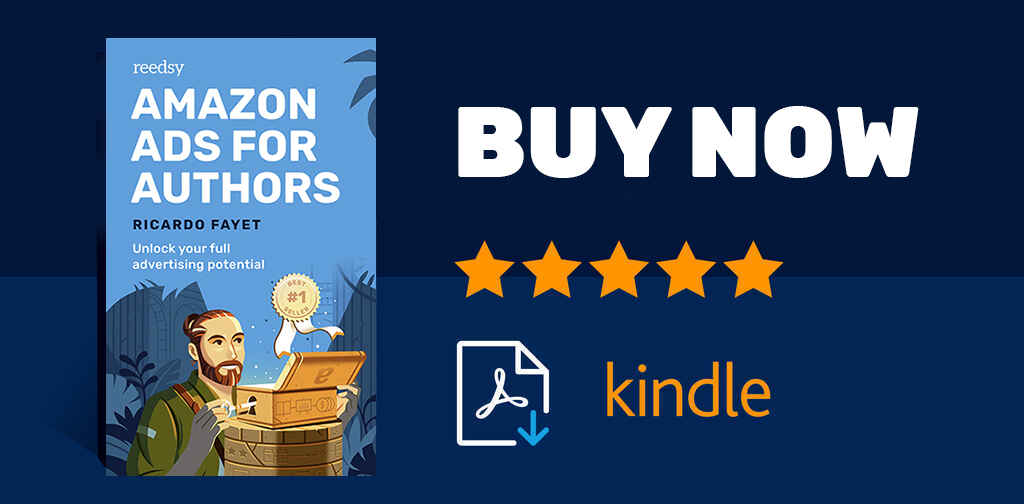Last updated on Dec 07, 2022
Amazon Ads for Authors: Magic Bullet or Waste of Time?
Ricardo Fayet
Reedsy co-founder and Chief Marketing Officer, Ricardo Fayet has worked with hundreds of authors on their launches and marketing campaigns. He is the author of two bestselling guides on marketing for authors, and a regular presenter at the largest writers' conferences.
View profile →Martin Cavannagh
Head of Content at Reedsy, Martin has spent over eight years helping writers turn their ambitions into reality. As a voice in the indie publishing space, he has written for a number of outlets and spoken at conferences, including the 2024 Writers Summit at the London Book Fair.
View profile →If you’re a self-publishing author, you’ve probably come across Amazon ads for authors before. Previously known as Amazon Marketing Services (AMS) and recently rebranded as Amazon Advertising, it’s a tool for writers to market directly on Amazon’s website.
Is this the magic marketing bullet you’ve been missing, or is it a waste of time? Let’s take a look at Amazon Advertising’s pros and cons so that you can decide for yourself.
We also recommend pairing this post with my book, Amazon Ads for Authors. It'll walk you through everything you need to know about Amazon Advertising step by step — from how to determine the type of ad campaign that will best suit your book to how to optimize your campaigns for profit.
The benefits of selling books with Amazon ads
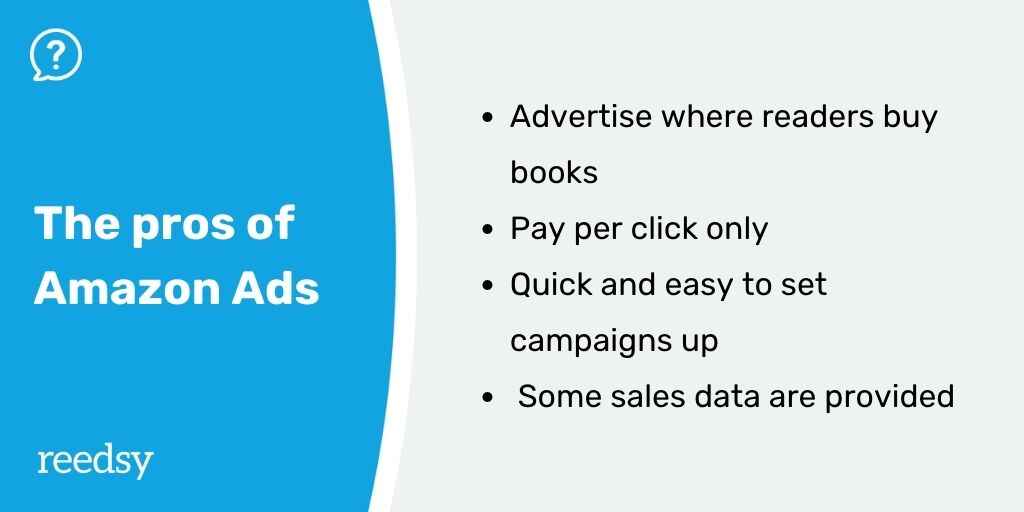 What are some reasons you should use Amazon ads to spread the word about your book? Here are the key benefits to this ad platform, especially when compared to alternatives like Facebook and BookBub ads.
What are some reasons you should use Amazon ads to spread the word about your book? Here are the key benefits to this ad platform, especially when compared to alternatives like Facebook and BookBub ads.
Advertise where readers buy books
Amazon Advertising is the only platform that lets authors advertise their titles where most readers will actually buy their books (as opposed to other platforms, where readers are distracted by videos of hilarious, adorable puppies).
Amazon’s Sponsored Product ads show up in the results when a user searches for something. For example, this is the sponsored results for a “time travel fiction” search.  This kind of ad can also appear in the “Also Bought” section of other books related to it. Here is an example of the sponsored section on the product page of Audrey Niffenegger’s The Time Traveler’s Wife.
This kind of ad can also appear in the “Also Bought” section of other books related to it. Here is an example of the sponsored section on the product page of Audrey Niffenegger’s The Time Traveler’s Wife.
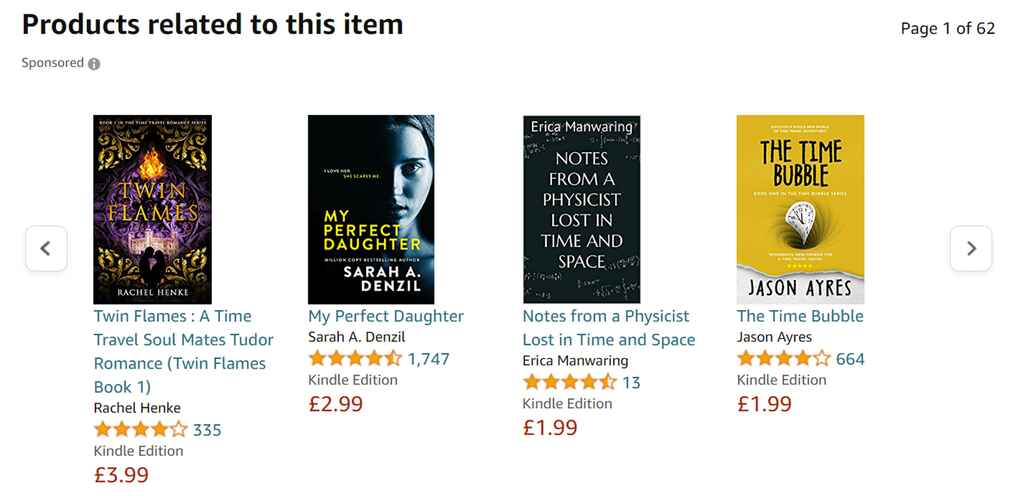 The great things about these advertisements is that they’re almost indistinguishable from organic search results; the only thing to set them apart is the fine print “Sponsored” label in the corner. Because of that, Sponsored Products don’t stand out blatantly as ads, and therefore don’t “intrude” on readers’ shopping experience.
The great things about these advertisements is that they’re almost indistinguishable from organic search results; the only thing to set them apart is the fine print “Sponsored” label in the corner. Because of that, Sponsored Products don’t stand out blatantly as ads, and therefore don’t “intrude” on readers’ shopping experience.
If you write series (as opposed to standalone books) and have published at least three titles, you can also guarantee a top spot on search result pages with a Sponsored Brand ad. This appears before the search results and includes an extra photo and short copy. For example, in the results for our “time travel fiction” search, there is a Sponsored Brand ad for H. Peter Alesso’s series before you even see the Jason Apsley book.
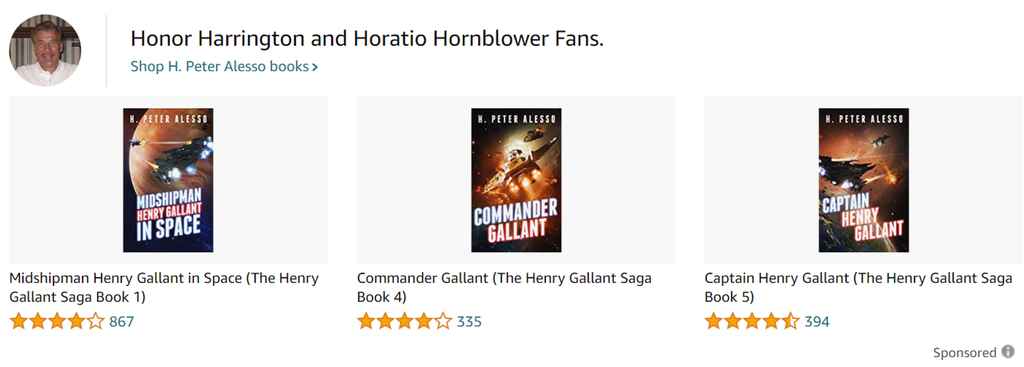 Even in this format, the ad doesn’t look too jarring. This is why Amazon ads are so effective: they’re seamlessly integrated into readers’ shopping experience.
Even in this format, the ad doesn’t look too jarring. This is why Amazon ads are so effective: they’re seamlessly integrated into readers’ shopping experience.
You pay per click, not per impression
While other popular advertising platforms (e.g. Facebook) make you pay for impressions, Amazon Advertising follows a “pay per click” model. Theoretically, you can get millions of impressions on your ads — thereby gaining a lot of brand exposure — and pay absolutely nothing unless those impressions lead to a click.
On top of that, this model is also more forgiving than paying for impressions. With Amazon ads, you can afford to go for slightly broader targeting, or even make a few mistakes without having to pay an arm and a leg for it. If you happen to choose the completely wrong targets and get no clicks on your ad, you don’t have to pay anything. Of course, that is not the goal, but it’s nice to know you have some room to experiment and learn the ropes of book advertising (especially when you have a limited budget).
Campaigns are quick to set up (no creatives required)
When running advertisements on other platforms, you often have to produce new creatives. Facebook and BookBub Ads, for example, both rely heavily on images. You’ll most likely have to work with a graphic designer to prepare material for those ads.
In contrast, Amazon Advertising automatically uses your book’s cover and metadata (title, subtitle, reviews, etc.) to generate ads. There are no requirements for a design or copy on your part if you go for Sponsored Product ads. All you have to do is decide on your targeting and bidding.
As such, it takes less than five minutes to set up your first auto targeting campaign (stay tuned, we’ll discuss what this means in the second post of this guide). Manual targeting may take a bit more time since you have to put together a list of keywords, products, or categories to target — but that’s about all you need to do to set a campaign up.
Get (some) sales data
Where Amazon Advertising truly outshines its competitors, though, is in its ability to deliver some actual sales data. You don’t have to guesstimate how many of your ads’ impressions and clicks led to book sales — Amazon Advertising tells you all this in the dashboard.
To be very clear, this data is not perfect. For instance, a reader could see your ad without clicking on it, and later decides to search your book up and buy it then; Amazon would not attribute that sale to your ads. (Spoiler alert: imperfect data will come up again when we look at the drawbacks of Amazon book advertising.)
That said, you still get records of sales from clicks on your ads, which is more than what other advertising platforms could offer. For books enrolled in KDP Select (and can thus earn royalties on the number of pages of your book that were read by readers after they borrowed it via Kindle Unlimited), Amazon Advertising also reports the total pages read generated by ads and the corresponding royalties.
All this can give you a better idea of which advertising strategy makes money and which loses money. Amazon even has a metric that gives you this information at a glance: the advertising cost of sale (ACoS). Accessible from your dashboard, it’s calculated using this formula:
ACoS = Spend / Sales
We’ll talk about how exactly you can use this later. For now, in terms of benefits, Amazon Advertising lets you directly advertise to buyers using a small budget and without any extra creatives, and it provides some data to help you analyze your own strategies. On the flip side, there are some limits to this platform.
The drawbacks of Amazon ads for authors
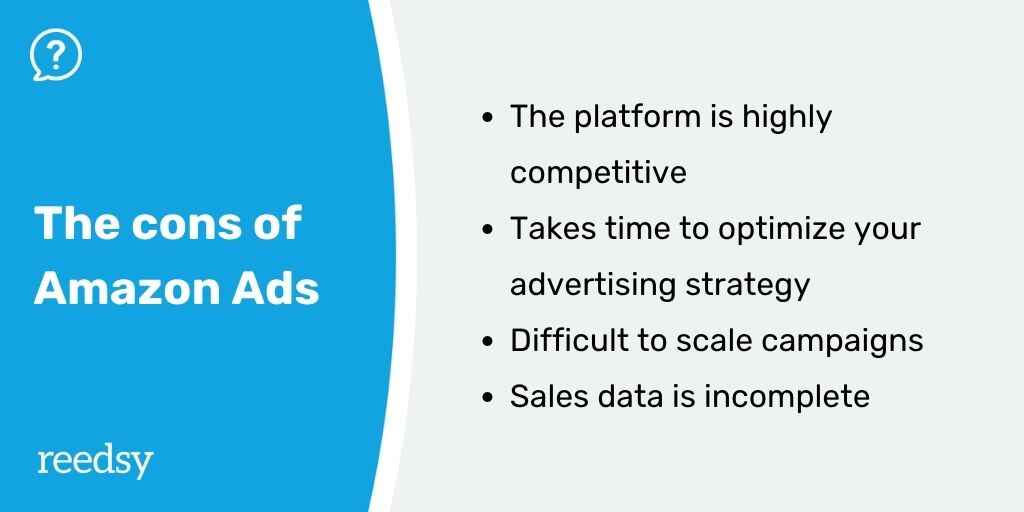 Everything comes with a good side and a not-so-good side. Before you make a decision on whether to use it or not, consider the following limitations of Amazon Advertising.
Everything comes with a good side and a not-so-good side. Before you make a decision on whether to use it or not, consider the following limitations of Amazon Advertising.
If you find yourself still struggling, of course, you can always consider hiring a book marketing professional to handle advertising for you. You can find the best on Reedsy below.
🧙🏼♂️ Hire an Amazon Ads wizard
Kate L.
Available to hire
10 yrs marketing experience in consulting, launching, and promoting books. Specialized in sci-fi, fantasy, gamelit/litrpg, spec fic, LGBTQ+
Caethes F.
Available to hire
I run AMS ads for some of the bestselling fantasy writers on Amazon. I specialize in fantasy and romance. Now accepting new clients.
Mamie S.
Available to hire
Customer-focused and strategy-driven digital marketer with 10 years of experience at Abrams Books and Simon and Schuster.
It’s a hyper-competitive ad platform
Because of all the benefits above, Amazon has become an incredibly popular platform for indie authors and traditional presses alike. And in the advertising world, “popular” generally means “competitive.”
Over the past few years, as more advertisers come onto the platform, costs per click have skyrocketed, making it ever harder to win impressions, clicks, and consequently sales. Unless you write in series, or in a specific nonfiction niche, it can be very hard to make your money back on Amazon ads.
This is perhaps why many authors are so keen to learn how to effectively use Amazon Advertising, with the help of various online courses on the topic. To make sure your knowledge and skills are on par with fellow advertisers, you may want to do some learning yourself — starting with our free course on Amazon ads.

FREE COURSE
Amazon Ads for Authors
Learn to reach readers while they browse the world’s biggest bookstore.
Optimizing your campaigns takes time
While setting up Amazon ad campaigns is relatively quick and straightforward, optimizing them can be quite time-consuming.
Amazon Advertising uses an auction system where advertisers bid against each other to get impressions on the advertising placements they want. Your bids determine both whether you win the auctions and your eventual cost-per-click. Bid too low and you’ll get few impressions. Bid too high and you’ll have to pay so high a cost-per-click to be able to make your money back in sales.
As a result, advertising on Amazon is often about continuously tweaking bids to figure out the right balance to keep your campaigns profitable, and ultimately scale them. This takes us to the next drawback:
It’s very difficult to scale campaigns
This is, by far, the #1 challenge authors face with Amazon Advertising. In many cases, it can be fairly easy to make your first campaigns profitable, but once you reach that point, it’s a struggle to get Amazon to spend more of your budget and boost your exposure.
It’s not just authors who are new to advertising who struggle with this. Self-publishing expert Mark Dawson shares:
“If your Sponsored Product ads are starting to work, then you’re probably, like myself, in a position where you want to spend more. So naturally, you increase your campaign’s budgets, and… little happens. Amazon is notoriously difficult to persuade to take more money from these ads (because they are charging by the click, not per impression).”
You can try to spend more of your budget by looking for more keywords and products relevant to your book to target, testing out different match types (exact, phrase, broad) for keyword targets, and slowly raising your bids. Given Amazon’s cost-per-click model, it doesn’t cost a lot to test things out, but the more niche your genre, the fewer of those relevant keywords and products there are — and the harder your campaigns are to scale.
Sales data is incomplete
While it’s great that Amazon shares some actual sales data in the dashboard, there is a catch. Amazon Advertising’s data is often incomplete, and not just because it’s tricky to decide how to attribute sales to ads.
Firstly, the “Sales” amount that Amazon reports is the total value of books sold as a result of the ads — not your net royalties as an author. You’re not breaking even when your Sales and Spend are equal (meaning your ACoS is at 100%), because only a fraction of the Sales will actually make it to your bank account.
Moreover, sales and Kindle Unlimited pages read are only reported within the first 14 days after a reader clicking on your ad. In other words, if a reader clicks on your ad and borrows your book through KU, but only starts reading it two weeks later, the royalties you get for the pages they read will not be reported.
This makes it hard to rely solely on the data from the Amazon Advertising dashboard to understand if your ads are actually profitable. Often, you’ll have to complement the Amazon Advertising data with that of your Kindle Direct Publishing dashboard to get the full picture.
If you see your KDP sales soar after starting a new Amazon Advertising campaign, you can be fairly sure that these new sales are coming from the ads — whether they’re all reported in the Amazon Advertising dashboard or not.
To wrap up, Amazon Advertising is a beginner-friendly platform that lets you quickly set up ad campaigns even when you’re on a tight budget.
There are challenges when it comes to scaling and optimizing your strategies, especially since the platform is increasingly popular among authors, but if you’re ready to overcome these, continue to the next post in this guide and we’ll walk you through how to set up and monitor your campaigns.
